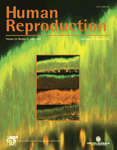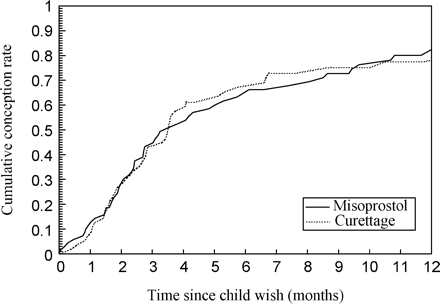-
PDF
- Split View
-
Views
-
Cite
Cite
Giuseppe C.M. Graziosi, Hein W. Bruinse, Paul J.H. Reuwer, Olgavan Teteringen, Ben W.J. Mol, Fertility outcome after a randomized trial comparing curettage with misoprostol for treatment of early pregnancy failure, Human Reproduction, Volume 20, Issue 6, June 2005, Pages 1749–1750, https://doi.org/10.1093/humrep/deh754
Close - Share Icon Share
Sir,
Dilatation and curettage is currently the cornerstone in the treatment of women with early pregnancy failure. Misoprostol has been presented as a non-surgical alternative for curettage in these women. We previously reported on a randomized trial which showed that women treated with misoprostol had a 53% complete evacuation rate without additional surgery, whereas in the curettage group 96% had complete evacuation after the initial procedure (Graziosi et al., 2004). Since most women with early pregnancy failure aim for a renewed pregnancy, a study was performed on fertility outcome. During the end of 2004, we contacted the 154 women included in this study that had been run from November 2001 to June 2003. We excluded eight women who had had early pregnancy failure after treatment with assisted reproductive technology. Follow-up data were lacking in five women who could not be contacted since they had moved to another location. Fifteen women had not tried to conceive since their early pregnancy failure.
In a telephone survey, women were asked about the time they had been trying to conceive, and on the occurrence and outcome of subsequent pregnancies (renewed pregnancy failure, occurrence of preterm delivery, form of delivery, difficulties in placental removal and haemorrhage). Of the 126 women who had tried to conceive, 69 had been allocated to misoprostol (37 needed additional curettage) and 57 allocated to curettage (two needed recurettage).
Cox's proportional hazards estimates of the relative risks (RRs) were 0.98 [95% confidence interval (CI) 0.68–1.4] for conception and 0.98 (95% CI 0.66–1.5) for ongoing pregnancy at 12 weeks. Kaplan–Meier curves of the ongoing pregnancy rates are shown in Figure 1. The cumulative conception rates were 94% in each of the groups, whereas cumulative ongoing pregnancy rates were 87% in both groups. Most of the women conceived within 6 months after trying to conceive. There were 5% (three out of 60) pregnancy complications (i.e. haemorrhage post-partum, operative removal of placenta, rhesus sensibilization and preterm delivery) in the misoprostol group versus 14% (seven out of 50) in the curettage group (RR 0.68; 95% CI 0.31–1.5). The caesarean rate was comparable in both groups (7.3 versus 6.5%, respectively).
Previous studies reporting on fertility after curettage as compared with conservative management for early pregnancy showed no differences between these treatment strategies (Kaplan et al., 1996; Blohm et al., 1997). This follow-up study shows that a strategy starting with misoprostol or curettage for early pregnancy failure does not affect future fertility. Moreover, fertility rates are similar to those reported among the normal population (Speroff et al., 1994).
Time since child wish after therapy for early pregnancy failure: misoprostol versus curettage.
References
Blohm F, Hahlin M, Nielsen S and Milsom I (
Graziosi GCM, Mol BWJ, Reuwer PJH, Drogtrop A and Bruinse HW (
Kaplan B, Pardo J, Rabinerson D, Fisch B and Neri A (
Author notes
1St Antonius Hospital, Koekoekslaan 1, 3435 CM, Nieuwegein, 2University Medical Centre, Heidelberglaan 100, 3584 CX Utrecht, 3St Elisabeth Hospital, Hilvarenbeekseweg 60, 5022 GC Tilburg, 4TweeSteden Hospital, Dr Deelenlaan 5, 5042 AD Tilburg and 5Maxima Medical Centre, de Run 4600, 5504 DB Veldhoven, The Netherlands




